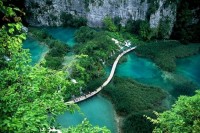 Excursions
Excursions

PLITVICE
Destination: Plitvice
City: Plitvice
Programme details
Plitvice lakes are the oldest and most famous national park in Croatia, its distinctiveness and uniqueness has been recognized worldwide, and in 1979. was included in the UNESCO List of World Cultural and Natural Heritage. The uniqueness of the lakes is also featured on the logo where the lakes and waterfalls are a phenomenon, formation of travertine which is why the Park and was declared a national park, forest and a bear show the diversity and richness of flora and fauna.
Plitvice Lakes National Park is located between Licke Pljesivice and Mala Kapela, a protected area is 29685.15 ha. Plitvice lakes formed by two rivers Black and White rivers, which together form the nut about one mile long, which empties into Lake Prošcanasko, which is still flowing creek and Ljeskovac Sušanj. From Proscansko lake to the north below the 16 named and several unnamed lakes that are connected over travertine barriers beautiful waterfalls and countless waterfalls.At the end of the lake are Sastavci in the immediate vicinity with a height of 78 meters of water crashing Plitvice brook, and so create a large waterfall, the largest and most beautiful waterfall in Croatia. Sastavak water and the Great falls merged and formed rivers Koran that penetrates through the canyon to the north.
The upper lakes are located on impermeable dolomite substrate, and the lower lakes are located in an easily soluble and permeable limestone. The most interesting phenomenon of this protected area is the water which takes place live continuous biochemical process of travertine formation. The basic phenomenon is the emergence of barriers when rainfall absorb carbon dioxide, and passing through the soil resulting carbonic acid which dissolves limestone and becomes saturated with water. Her burst leads to deposition of calcium carbonate. The formation of travertine are included sedrotvorne algae and moss genus Bryum Cratoneuron and that deposited calcium carbonate converted to travertine barriers and partitions. The whole area of the park is covered with forest in the bay Corkovoj goes into the jungle law. This is one of the most beautiful rainforest of the Dinarides.
In addition this area is rich in flora and fauna. Natural habitat, but in Europe prorijedenih animal species such as bear, lynx, wolf, wild cat, deer, deer, wild boar, badger, marten and pine marten. Inventory recorded 161 species of birds, 272 species of butterflies, 80 species of caddisflies, 7 fish, 2 spin higher crustaceans, 12 species of amphibians, 13 reptiles, 20 species of bats. Recorded and the abundance of plant species, over 1400, 72 endemic species, 22 species, 55 species of orchids, carnivorous plants 3.


